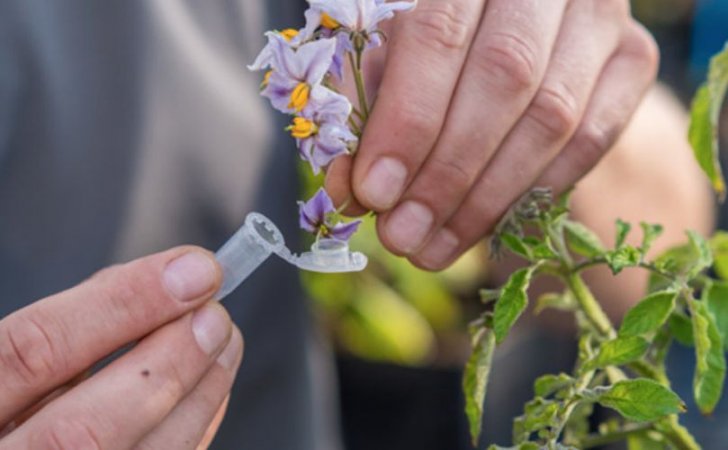Typically, potatoes are multiplied by replanting a small potato tuber from last season, causing it to grow a new potato plant.
Recently a new method of multiplication is making headlines: true potato seed (TPS) or botanical seed from hybrid potatoes. As the name already indicates, instead of a planting a tuber, you use seed, which you can simply sow.
Dutch seed potato company HZPC is at the forefront of this innovative research.
Breeding has meant that the potato has risen to great heights as a crop and there have been a great number of varieties produced with high production levels. The development of new varieties using classical techniques, however, takes a lot of time.
Research into a new method of breeding seems to provide opportunities for the future. It concerns the so-called hybridization of potatoes, coupled with production directly from seed, something that was not considered possible until recently.
Tests show that this method of breeding creates opportunities.
Robert Graveland, director of R&D at HZPC:
“As far as potatoes are concerned, this is a completely new approach to breeding.”
“We are excited about it and the fact it offers new opportunities for speeding up the genetic progress and ensuring control over including better properties.”
The potato berries are collected carefullyIn 2011, HZPC started work on extensively researching the new method. Last year saw the first test-hybrids in fields. It was exciting to harvest the results, said project leader Ad Vrolijk.
Ad Vrolijk:
“[…] We are very happy with the results. Certain combinations demonstrated, among other things, the desired ‘heterosis’.”
“That means that the performance and yields are better than those of the parent plants.”
It also means that this technology has proven itself when it comes to the basics. HZPC has therefore decided to scale-up research into this innovative form of breeding.
Recovering the seeds from the potato berriesThe experts nevertheless warn that there is still a long way to go.
Ad Vrolijk explains:
“The process is still posing many questions to which we need to find an answer. It will take years before the first hybrid potatoes reach the market.”
The biggest obstacle is the yield of the hybrids, which is significantly behind that of current varieties. HZPC expects by 2021 at the earliest to have found a proven prototype, which can then be put on sale after a few years.
They will start off in developing countries in Central Africa and Asia, where yields are lower than 40 tons per hectare.
Ad Vrolijk:
“You can also quickly improve production by using hybrids.”
When will a hybrid potato be introduced in the Netherlands? According to Graveland, it is all a matter of time.
Robert Graveland:
“Who knows? Somewhere around 2035. Of course, you can never rule out that in the future, this development will take place quicker than we currently expect, but we have already a top segment of great varieties, with high yields.”
“Also, traditional breeding is not standing still when it comes to development. The hybrid still has a huge gap to catch up.”
HZPC thinks that botanical seeds may also play a role a long way into the future. These seeds propagate more quickly than seed potatoes and are easy to transport and store. However, the sale of a prototype of true seeds is not expected before 2025.
It is also very questionable whether botanical seeds will ever fully take over the role of seed potatoes. Graveland does not expect this to be the case for a long time, and “certainly not in modern agricultural areas like Northern Europe and North America.”
With a balanced botanical seed system, you could basically skip the cultivation of seed potatoes. In many countries, however, the growing season is too short to grow a full-grown crop from true seeds.
Ad Vrolijk:
“You can only use botanical seeds if the temperature is high enough as you can plant a tuber much earlier.”
“Moreover, seed potatoes have more growth power than true seeds and time is money.”
The project leader thinks the research programme is promising.
Ad Vrolijk:
“It is an important innovation that allows HZPC to grow strategically in new markets.”
“We hope that by using this method, we will be able to improve and replace our varieties more quickly in the long term.”
However, according to him, it is not necessary to experience market unrest. Traders and growers in seed potatoes will notice very little of the developments for the time being.
Ad Vrolijk:
“We do not foresee any sudden changes in this sector.”
“And, even though in the future we will work with hybrids and with botanical seeds in certain areas, there will always be a need for high-quality seed potatoes.”

